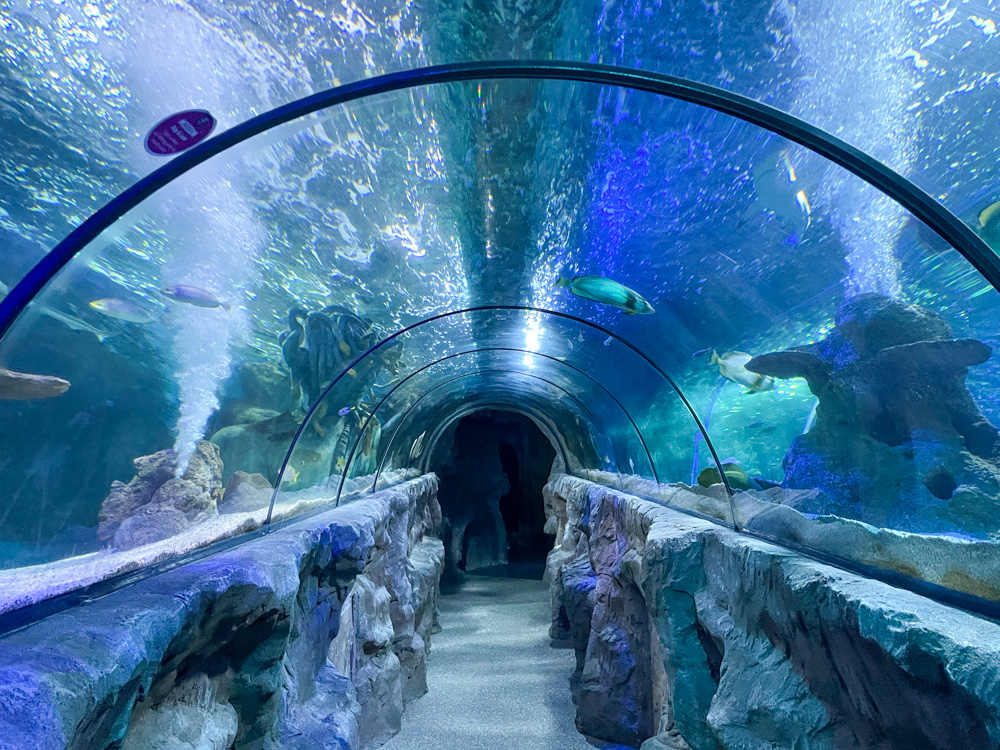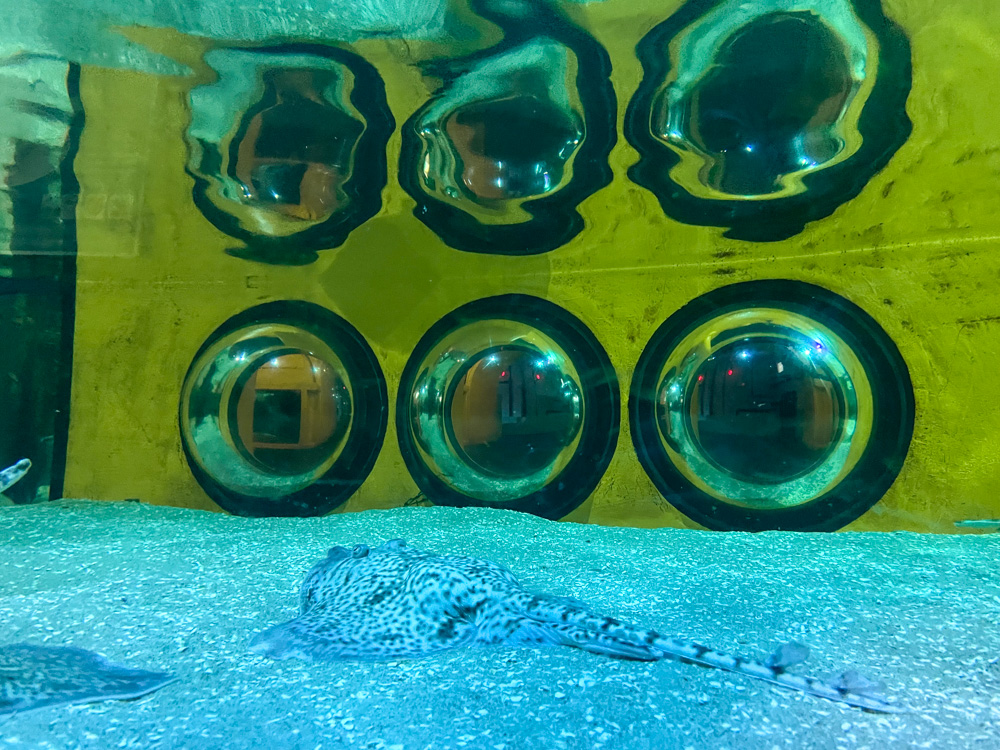Great Yarmouth is home to one of the British SEA LIFE aquariums, a must-see attractions on the Norfolk coast, especially if you’re traveling with children. Here you will learn all about life on the coasts, you will be able to stroke starfishes and see the penguins in an open space. On the other hand, children will go crazy in the underwater space where they can observe the depths of the sea from a porthole of a submarine.
What to see at the SEA LIFE Great Yarmouth aquarium
SEA LIFE aquariums are found all over the world, from Europe to Asia. In the United Kingdom there are about ten SEA LIFE aquariums, the most famous of which is probably the one in London.
The SEA LIFE Great Yarmouth aquarium is smaller, but from an educational point of view it has nothing to envy to its more famous brothers. In fact, it offers the opportunity to get to know many species of aquatic animals and reptiles up close. The most loved of the Great Yarmouth aquarium are certainly the Humboldt penguins, but you can also watch seahorses and curious fish with legs.
The most iconic area of the aquarium is its Ocean Tunnel, typical of all SEA LIFE aquariums. In Great Yarmouth the Ocean Tunnel hosts the largest fish and contains 250,000 liters of natural seawater. It was a real thrill walk under a shark!

Humboldt penguins
The Humboldt Penguins are a South American species that reproduces mainly in the north of Chile. In the wild they are decreasing in number and it is thought that only 10,000 individuals remain free. The increase in water temperature in fact causes the reduction of the animals they feed on, in a devastating chain effect.
In fact, Humboldt Penguins are purely carnivores, they only eat meat. Their diet includes small crustaceans, squid and fish. At the Great Yarmouth aquarium they live in a very suggestive open space, from which you can see the background of the beach and the pier.
Rays
In the Under the Ray-dar area you can have fun identifying the different species of races. SEA LIFE Great Yarmouth hosts both the cownose breed and the wavy breed in its tanks. In recent years, populations of wavy rays have declined considerably as they were wild fished for their meat with bottom trawls and gillnets.
My son got hooked on stingrays because their tank is the one in the main room where the submarine is located. Mark it if you visit SEA LIFE with children because it will be the place where you will spend the most time!
The rays still seem incredibly peaceful, but are able to defend themselves strongly if they feel threatened. In fact, the rays can raise their tails to pierce an attacker with their poisonous sting. Once they hit their predator, it takes some time for a new spike to grow back, so they use this defensive tactic only as a last resort!
Seahorses
Seahorses are absolutely fascinating animals. Their peculiarity, which distinguishes them from all other fish, is the physical structure in an upright position. Their prehensile tails help them not get carried away by the current, hooking on to corals and algae.
Seeing seahorses at SEA LIFE Great Yarmouth gave me hope in evolution because at least they apply gender equality. Male seahorses “hatch” their offspring in a belly pouch where a female can lay eggs. After a few weeks, the male seahorse “gives birth” by letting the young come out of a hole in its belly.
There are over 40 species of seahorses, distributed in oceans around the world. Some live on coral reefs, others in mangrove roots, and many in seaweed-rich bottoms. Two species of seahorses even live in the waters around Ireland and the UK!
The various species also differ in size. For example, pygmy seahorses are as small as a fingernail, while others are larger than a hand. At SEA LIFE they are in a tank next to that of the stingrays. Not being very big, you may have to pay a little more attention to identify them among the algae.

Sea turtles
At SEA LIFE Great Yarmouth you absolutely must also see sea turtles. They have existed for over 200 million years and that means they shared our planet with the first dinosaurs (absolutely worth mentioning to dinosaur-loving children!).
The most famous turtle in the Great Yarmouth aquarium is undoubtedly Noah, an eleven-year-old vegetarian green turtle born in captivity in a turtle sanctuary in the Cayman Islands.
SEA LIFE promotes awareness of the risks of pollution and clearly explains how plastic bags are deadly for sea turtles. In fact, they often mistake them for jellyfish, their favorite food, and suffocate trying to eat them. After reading these explanations and seeing sea turtles live, you will probably no longer buy plastic bags from the supermarket so lightly.
Jellyfish
The Jelly Invaders area is another classic of modern aquariums, with jellyfish “dancing” wrapped in multicolored lights. I had seen a similar setup in different aquariums around the world and these spaces are perfect for changing your opinion about these animals, despite the annoyance of finding a jellyfish in the sea.
Jellyfish are among the oldest animals and scientists believe they may have appeared around 500 million years ago. There are more than 350 different species of jellyfish.
At SEA LIFE Great Yarmouth you can see Moon Jellyfish, a common species found throughout the UK, and track their life cycle. These jellyfish can withstand temperatures between 6 and 31 degrees and have venomous tentacles that they use to catch prey, but their sting is quite mild.
Not to miss: activities at SEA LIFE Great Yarmouth
If the main attractions of SEA LIFE Great Yarmouth are the fish housed in the aquarium, the experience would not be the same without participating in activities such as talks and animal feeding. Also along the tour there are several interactive areas to find out more about the animals housed.
The rocky habitat of the Rockpool Explorer Experience is certainly one of the experiences not to be missed. Here you can see animals that have adapted to living in the shallow pools of the British coast and even touch a starfish that seems totally indifferent to the idea of being caressed by visitors.
Entering the Under the Ray-dar ray area you will find yourself in a research submarine to find out all about these fascinating fish. The habitat of the tropics, on the other hand, was set up in an incredible tunnel that takes up the theme of the Lost City of Atlantis.
This is just to give you some anticipation, because SEA LIFE Great Yarmouth is really full of settings not to be missed. Such as sea anemones, clownfish, marine conservation activities and more.
Rockpool Explorer Experience
Rockpools along the British coast are formed from the water left in the potholes when the tide recedes. They are amazing micro-habitats for creatures able to adapt to different temperatures and to the waves crashing above them.
The Rockpool Explorer Experience area is famous because here you can see and touch starfishes and anemones. Under the control of SEA LIFE staff, and after having thoroughly washed your hands, they can only be gently caressed.
An interesting aspect of the Rockpool Explorer Experience area of SEA LIFE Great Yarmouth is that it explains to visitors how to behave on the beach. After the visit, you will be able to explore this environment in safety for you and for the animals that populate it: from wearing non-slip shoes to respecting all sea creatures.
How SEA LIFE protects the marine environment
Like all modern aquariums, SEA LIFE Great Yarmouth also helps protect the marine environment and does so through the group’s charity, the SEA LIFE Trust.
Thanks to the SEA LIFE Trust, new marine protected areas have been created, marine litter reduced and various activities for the protection of animals started. At the time of writing, SEA LIFE Trust manages two protected areas:
- the Beluga Whale Sanctuary in Iceland
- the Cornish Sea Sanctuarye in the United Kingdom
The Beluga Whale Sanctuary, located off the southern coast of Iceland, is the first of its kind in the world: it offers a new home for animals previously in captivity. The Cornish Seal Sanctuary, on the other hand, takes care of sick and injured seal pups and then releases them into their natural environment.
SEA LIFE regularly organizes beach cleaning activities open to all. If you are in the area during one of these events, do not hesitate to participate, families are welcome.

Visiting SEA LIFE Great Yarmouth: what to know
SEA LIFE Great Yarmouth is absolutely worth a visit, especially if you are traveling with children. Best to know, it’s better to visit the aquarium in the early morning, as soon as it opens, because it is not very big and gets crowded easily. If the little ones are tired of the visit, there is an area inside SEA LIFE Great Yarmouth where they can draw and colour sea-themed pictures with Peppa Pig.
It must be said that SEA LIFE tickets aren’r cheap, as in almost all aquariums. Standard Tickets start at £ 17. Only children up to three years old get in free, older children pay almost the same as an adult. You can save some quids booking online.
Where is SEA LIFE Great Yarmouth
The SEA LIFE aquarium is located on Great Yarmouth’s waterfront. You can park your car along the road, but if you’re already in Great Yarmouth you can reach the aquarium on foot or by the cute small tourist train who ride on the beachfront.
SEA LIFE Great Yarmouth
Marine Parade
Great Yarmouth NR30 3AH
Share your thoughts and experiences about SEA LIFE Great Yarmouth in the comment sections and have a great visit there.

